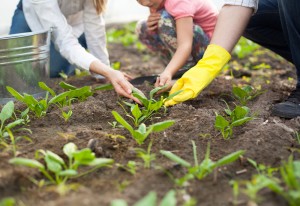 A communal garden instills a sense of camaraderie and community in addition to providing a bounty of fresh food and beauty. Starting one in your apartment building or complex is relatively easy as long as you stay organized. The result is a gorgeous green garden where neighbors can work together, kids can play, and a wonderful environment for the neighborhood.
A communal garden instills a sense of camaraderie and community in addition to providing a bounty of fresh food and beauty. Starting one in your apartment building or complex is relatively easy as long as you stay organized. The result is a gorgeous green garden where neighbors can work together, kids can play, and a wonderful environment for the neighborhood.
Put Together Your Garden Planners
If there’s no organization to your garden, it will get out of hand very quickly. Put together a committee to plan everything. To keep things fair, think about getting together with everyone who’s interested and having them nominate committee members. Hold a vote so that everything’s perfectly democratic. For smaller gardens, a committee of three members is ideal. Larger gardens may need up to five members. Stick to odd numbers so there’s always a tie-breaker.
Plot Out Your Garden
Plotting out your garden is very important, because some flowers and plants need full sunlight, some thrive in the shade, and some need a mix. You also need to decide how you’re going to water it; you can use sprinklers or water manually with a hose.
If you have a small garden, you’ll have to plot with special care. At this stage you might want to think about doing a raised garden to maximize your space. That can allow you to plant more than you could otherwise, because you’ll have more opportunities for sun-happy plants or combination vegetables.
Raised beds work well for larger gardens too, but you have more space so you don’t necessarily have to use them. However, with a bigger plot of land, you don’t want to overwhelm yourself with too many plantings either.
Choose What to Plant
From perennials to annuals, from fruits and vegetables to flowers, you have endless choices. If you simply want to create an abundance of fresh produce for everyone, then make yours a fruit and vegetable garden. Remember, however, that flowers, trees, and shrubs add a wealth of beauty and oxygen to your space. If you choose perennials such as peonies, rhododendrons, irises, and hydrangea, you won’t have to spend as much time caring for them.
Fruits and vegetables need more vigilance. If there’s someone participating who’s excellent at growing tomatoes or a resident with a green thumb for green beans, put them in charge of those sections. You may also want to allow everyone to choose and tend to their own plots. That way everyone contributes something at which they excel, which nurtures feelings of pride.
Prepare Everything Together
Preparing the soil is a big job. You have to turn the soil, plant the seeds, and water everything appropriately. Doing all of this together saves time and brings the community closer. Create sub-committees or simply invite everyone to help, whatever works best for your group. It’s a good idea to have watering and feeding schedules as well.
A communal garden adds natural beauty and delicious food to the home you all share. It’s great for the environment and increases the value of your space.

